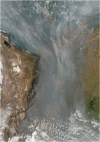Fire and deforestation dynamics in Amazonia (1973-2014)
- PMID: 28286373
- PMCID: PMC5324547
- DOI: 10.1002/2016GB005445
Fire and deforestation dynamics in Amazonia (1973-2014)
Abstract
Consistent long-term estimates of fire emissions are important to understand the changing role of fire in the global carbon cycle and to assess the relative importance of humans and climate in shaping fire regimes. However, there is limited information on fire emissions from before the satellite era. We show that in the Amazon region, including the Arc of Deforestation and Bolivia, visibility observations derived from weather stations could explain 61% of the variability in satellite-based estimates of bottom-up fire emissions since 1997 and 42% of the variability in satellite-based estimates of total column carbon monoxide concentrations since 2001. This enabled us to reconstruct the fire history of this region since 1973 when visibility information became available. Our estimates indicate that until 1987 relatively few fires occurred in this region and that fire emissions increased rapidly over the 1990s. We found that this pattern agreed reasonably well with forest loss data sets, indicating that although natural fires may occur here, deforestation and degradation were the main cause of fires. Compared to fire emissions estimates based on Food and Agricultural Organization's Global Forest and Resources Assessment data, our estimates were substantially lower up to the 1990s, after which they were more in line. These visibility-based fire emissions data set can help constrain dynamic global vegetation models and atmospheric models with a better representation of the complex fire regime in this region.
Keywords: Amazonia; South America; deforestation; historic fire emissions; horizontal visibility; proxy data.
Figures









References
-
- Akagi, S. K. , Yokelson R. J., Wiedinmyer C., Alvarado M. J., Reid J. S., Karl T., Crounse J. D., and Wennberg P. O. (2011), Emission factors for open and domestic biomass burning for use in atmospheric models, Atmos. Chem. Phys., 11(9), 4039–4072, doi:10.5194/acp-11-4039-2011. - DOI
-
- Aragão, L. E. O. C. , Poulter B., Barlow J. B., Anderson L. O., Malhi Y., Saatchi S., Phillips O. L., and Gloor E. (2014), Environmental change and the carbon balance of Amazonian forests, Biol. Rev., 89(4), 913–931, doi:10.1111/brv.12088. - DOI - PubMed
-
- Artaxo, P. , Gerab F., Yamasoe M. A., and Martins J. V. (1994), Fine mode aerosol composition at three long‐term atmospheric monitoring sites in the Amazon Basin, J. Geophys. Res., 99(D11), 22,857–22,868, doi:10.1029/94JD01023. - DOI
-
- Bevan, S. L. , North P. R. J., Grey W. M. F., Los S. O., and Plummer S. E. (2009), Impact of atmospheric aerosol from biomass burning on Amazon dry‐season drought, J. Geophys. Res., 114, D09204, doi:10.1029/2008JD011112. - DOI
-
- Chang, D. , Song Y., and Liu B. (2009), Visibility trends in six megacities in China 1973–2007, Atmos. Res., 94(2), 161–167, doi:10.1016/j.atmosres.2009.05.006. - DOI
LinkOut - more resources
Full Text Sources
Other Literature Sources
